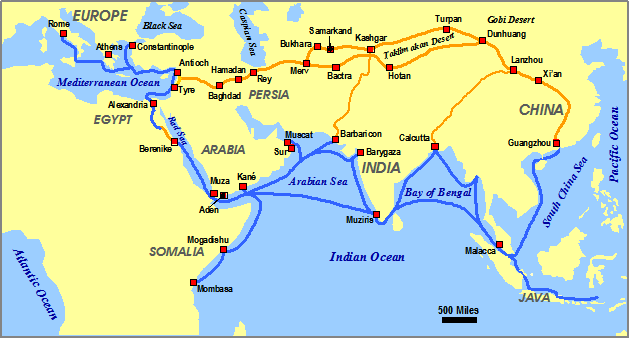If we go back to the second and third centuries C.E. and to the trade routes of the Silk Roads, we find the Chinese Han Dynasty and the Roman Empire suffering large-scale outbreaks of epidemic disease.1 The most destructive of these diseases were probably smallpox and measles, and epidemics of bubonic plague may also have erupted.2 Although these diseases are the most well-known, there were many others. We have long suspected that disease traveled via the Silk Roads; and now we have the proof. Piers Mitchell, a paleopathologist at the University of Cambridge states, “This is the earliest evidence for the spread of infectious diseases along the Silk Road, and the first to find evidence at an archaeological site along the Silk Road itself.”3 Without the technology and medicinal techniques we practice today, the fatalities that these populations suffered were devastating.

The silk roads were an extensive series of trade routes that linked much of Eurasia and north Africa.4 The Xuanquanzhi relay station was a well known area along the Silk Roads that housed travelers and relayed messages. It was located in the town of Dunhuang, a key stopping point on the Silk Road within the Hexi Corridor.5 Not only were necessities exchanged here, but so were religions, cultures, and the many diseases. Through a study in China conducted by Doctors Hui-Yuan Yeh, Ruillin Mao, Hui Wang, Wuyun Qi, and Piers D. Mitchell, they were able to prove that Chinese liver fluke, roundworm, whipworm, and tapeworm were spread along the Silk Roads.6
The study took place in Gansu Province, located in north-west China, which contains the Hexi Corridor.7 This corridor formed a section of the Silk Road, an ancient network of thoroughfares extending 4000 miles.8

Hygiene sticks were excavated from the latrines at the Xuanquanzhi site in 1992. These sticks were made of wood or bamboo wrapped with cloth, to be used as personal hygiene sticks for wiping.9 Out of the many sticks that were collected, seven of them had remnants of fecal matter still attached. The samples were then mixed with distilled water and trisodium phosphate in order for the parasites to be isolated. The most significant finding was the Chinese liver fluke, as it could not have been endemic at Dunhuang, as the parasite requires a wet marshy environment for its life cycle.10 Due to the discovery of this specific parasite, it proves the argument that the Silk Roads were partly to blame for the mass distribution of diverse diseases. Although there are various ways for diseases to be distributed all over the world, travelers along the Silk Roads provided an easy way for some of the most deadly diseases to travel great distances to devastate two of the largest empires of the ancient world: the Chinese Han Dynasty and the Roman Empire.
- Jerry H. Bentley, Herbert F. Ziegler, and Heather E. Streets-Salter, Traditions & Encounters: A Brief Global History: Volume 1: To 1500, Fourth Edition, vol. 1 (New York, New York: McGraw-Hill Education, 2014), 166. ↵
- Bentley, Ziegler, and Streets-Salter, Traditions & Encounters: A Brief Global History, 166. ↵
- Charles Q. Choi, “Silk Road Gave Infectious Disease a Route, Ancient Poop Shows,” Live Science, July 21, 2016, accessed October 25, 2016, http://www.livescience.com/55505-silk-road-human-feces-infectious-disease.html. ↵
- Bentley, Ziegler, and Streets-Salter, Traditions & Encounters: A Brief Global History, 161. ↵
- Hui-Yuan Yeh et al., “Early Evidence for Travel with Infectious Diseases along the Silk Road: Intestinal Parasites from 2000 Year-Old Personal Hygiene Sticks in a Latrine at Xuanquanzhi Relay Station in China,” Journal of Archaeological Science: Reports 9 (October 2016): 759. ↵
- Hui-Yuan Yeh et al., “Early Evidence for Travel with Infectious Diseases along the Silk Road: Intestinal Parasites from 2000 Year-Old Personal Hygiene Sticks in a Latrine at Xuanquanzhi Relay Station in China,” Journal of Archaeological Science: Reports 9 (October 2016): 758. ↵
- Hui-Yuan Yeh et al., “Early Evidence for Travel with Infectious Diseases along the Silk Road: Intestinal Parasites from 2000 Year-Old Personal Hygiene Sticks in a Latrine at Xuanquanzhi Relay Station in China,” Journal of Archaeological Science: Reports 9 (October 2016): 759. ↵
- Hui-Yuan Yeh et al., “Early Evidence for Travel with Infectious Diseases along the Silk Road: Intestinal Parasites from 2000 Year-Old Personal Hygiene Sticks in a Latrine at Xuanquanzhi Relay Station in China,” Journal of Archaeological Science: Reports 9 (October 2016): 759. ↵
- Hui-Yuan Yeh et al., “Early Evidence for Travel with Infectious Diseases along the Silk Road: Intestinal Parasites from 2000 Year-Old Personal Hygiene Sticks in a Latrine at Xuanquanzhi Relay Station in China,” Journal of Archaeological Science: Reports 9 (October 2016): 759. ↵
- Hui-Yuan Yeh et al., “Early Evidence for Travel with Infectious Diseases along the Silk Road: Intestinal Parasites from 2000 Year-Old Personal Hygiene Sticks in a Latrine at Xuanquanzhi Relay Station in China,” Journal of Archaeological Science: Reports 9 (October 2016): 761. ↵



34 comments
Nathan Alba
I never really thought about how diseases got around back in those days. I forgot exactly how the silk road really connected the world. I did think the way the scientists tested for the apparent disease was disgusting, but I guess sometimes you got to do what you got to do. What would be interesting would be to see how diseases were different back then compared to now. But then again I’m glad I didn’t live back then, clearly they didn’t exactly keep up with their hygiene like people do today.
Taylor Rech
When I took world history in high school, I learned about the Silk Roads being trade routes for goods as well as diseases due to the interactions of people across the continent that were previously not connected. However, I never considered that there was no proof of this because I always thought that it did not need to be explained; people who had previously not interacted were now able to do so and disease was spread through breathing and touching. On the other hand, I find the research that this article mentions to be very interesting because it turns our assumptions into facts, and I think that it is remarkable that usable data could be found after thousands of years have passed.
Rolando Mata
As an individual that has never heard of this sickness or issue before, I found this article to be gripping in touching on such a non-known topic. it’s even more baffling that the professionals were able to still have evidence of fecal matter and the parasites that used to live inside.I also find it a little ironic that the silk road which was meant to distribute and support growing economy, was plagued with sickness and was a strong cause of the growth of various diseases in ancient times.
Evelin Joseph
I have heard of the Silk Road and the many trade advancements it brought about, but learning about the death and disease it also transferred was truly an eye-opening experience. Along with religions, cultures, and goods, it is scary to think that such an advancement in society also brought about death and sickness. It is also interesting to hear that there was no proof of this event until after 1992. To think that this trade route could affect huge empires like the Chinese and Romans truly makes you think about the power hidden in diseases and unhygienic practices.
Megan Barnett
Interesting topic and information I had no idea that we had proof of disease being carried along the Silk Road. I also did not know that there was such a thing as a hygiene stick, so I would have never of guessed that you could find such information from this object. You included pictures that helped in visualizing what was being mentioned, but I could not decipher what the one of the excavation site included.
Edith De Loera
I was immediately drawn to this article because of its witty title, kudos. The Silk Road was widely known as a trade route of both goods and information. I learned about it in grade school but never learned about the diseases that were spread. Back then, they were not as scientifically advanced as we are now, so they did not have the luxury of being diagnosed and treated quickly for any illness. Great article, very informative!
Josselyn Arrieta-Meraz
This article was so interesting to read, and be reminded of the number of diseases that once took over humanity affecting not only a few but actual populations. The Silk Road was known for the amount of trade and other resources, but what I was not aware of was those who it affected like The Chinese Han Dynasty, and the Roman Empire. The fact that now in days diseases are still spread easily even though we are more technologically advanced in medicine and healthcare, really puts into perspective on how people must have felt at that time, without a sense of control and hope.
Steven Clinton
Fascinating! When you think of the great travel routes like the Silk Road many people often forget how unsanitary these roads are.Significant amounts of Bacteria and Parasites were latently distributed through the road, and that cause many epidemics within the Han Dynasty and Roman Empire. It’s interesting to see the development of cleanliness and good hygiene throughout the ages. Excellent Article!
Mariana Govea
Well written article! I had never heard of how diseases spread fast throughout the silk roads! It was a very interesting read! Its really interesting how you point out how essential these roads were to people,since they depended on them for trade as well as getting from one place to another! it is so crazy that the roads were so important to these people that many of them ended up catching diseases that were being spread through the use of the Silk roads! Which after reading this informative article it makes sense on how disease spread so fast, because everyone was traveling through the same routes and having the same destination therefore it was so easy to contaminate the people around you! Great job!
Alexis Soto
I wrote an essay on the Mongol Empire and through my research I discovered their relationship to the Black Plague. The Mongols had expanded the silk road to such a degree some would argue that they began international commerce. The increase of trade would allow for the increase of potential spread of disease and the Mongols were known to occasionally use disease as a form of biological warfare. Increase of trade although good in many ways seems to have come at a price.